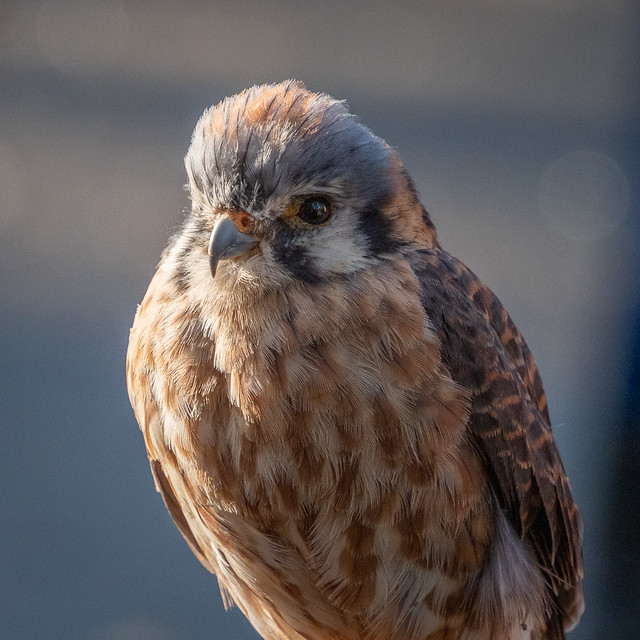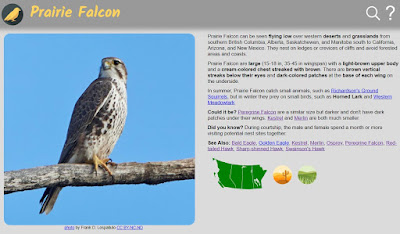Falcons have thin, pointed wings that allow them to fly very fast. Western Canada is home for at least part of the year to kestrels, merlins, peregrine and prairie falcons.
Kestrel
American kestrels are North America’s smallest falcon. They are less than a foot long with a wingspan of less than two feet. They can be seen in Canada in the summer before migrating to the southern United States for the winter.
Kestrels hunt for insects, small rodents, and birds in grassy or desert areas with few trees. Look for them perched on fence posts and utility poles or hovering over a field on rapidly beating wings. Kestrels are smaller and more colourful than other falcons with reddish-brown bodies, a pale belly, and two vertical black stripes on either side of their white cheeks. The males have a blue-grey head and wings.
Did you know? If kestrels kill more than they can eat, they hide the excess in holes or under grass clumps and tree roots for days when they're less successful.
Merlin
Merlins are small, stocky falcons with a broad, heavily streaked chest and a banded, medium-length tail. Males are dark grey, while females and juveniles are browner. Merlins fly fast and low with rapid wingbeats and are fierce hunters of small birds, dragonflies, and bats, which they capture in mid-air. Merlins are darker and stockier than other falcons and beat their wings more rapidly when flying. Their shrill, chattering cry is very distinctive and can last for up to 4 seconds.
Merlins prefer open forests, grasslands, and coastal areas where there are flocks of small songbirds or shorebirds. They can sometimes be found in prairie towns and cities where they can count on a steady supply of sparrows.
Did you know? Merlins will sometimes hunt in pairs. One will disturb a flock of waxwings from below and the other will take advantage of the confusion to attack.
Peregrine Falcon
By the mid-1900s, peregrine falcons had almost disappeared in North America, but they’ve made an amazing recovery and are now most commonly found in coastal areas and cities. They’re a medium-sized bird (14 in) with a wingspan of 3-3.5 feet. Peregrine falcons have a blue-grey back, a cream-coloured chest with dark markings, and bright yellow feet and legs. Dark feathers on the head and sides of the neck look like a helmet.
Peregrine falcons sit on high perches making swift, steep dives to catch their prey - ducks and shorebirds or pigeons in the cities.
Did you know? The peregrine falcon may be the fastest bird in the world reaching speeds of up to 238 mph when diving after prey.
Prairie Falcon
Prairie falcons can be seen flying low over the deserts and grasslands of southern Saskatchewan, British Columbia, and Alberta. They've adapted well to human habitation and can often be found in cities or farm country in the winter. They avoid forested areas and coasts.
Prairie falcons are large (15-18 in, 35-45 in wingspan) with a light brown upper body and a cream-coloured chest streaked with brown. There are brown vertical streaks below their eyes and dark-coloured patches at the base of each wing on the underside.
Peregrine and prairie falcons are larger than merlins and kestrels. Peregrine falcons have a dark helmet, while prairie falcons have dark patches under their wings.
Did you know? During courtship, the male and female spend a month or more visiting potential nest sites together.
See Also
EcoFriendly Sask supports Saskatchewan environmental initiatives through an online publication, an events calendar, small grants, and the Nature Companion website/app.



